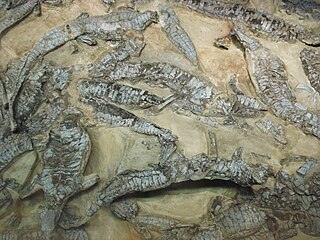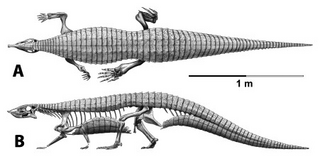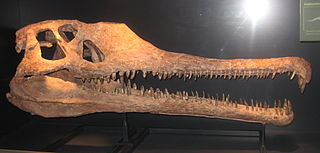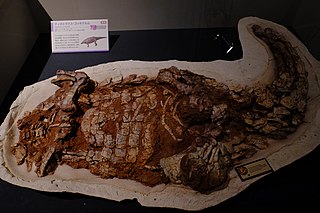
Aetosaurs were heavily armored reptiles belonging to the extinct order Aetosauria. They were medium- to large-sized omnivorous or herbivorous pseudosuchians, part of the branch of archosaurs more closely related to crocodilians than to birds. All known aetosaurs are restricted to the Late Triassic, and in some strata from this time they are among the most abundant fossil vertebrates. They have small heads, upturned snouts, erect limbs, and a body ornamented with four rows of plate-like osteoderms. Aetosaur fossil remains are known from Europe, North and South America, parts of Africa and India. Since their armoured plates are often preserved and are abundant in certain localities, aetosaurs serve as important Late Triassic tetrapod index fossils. Many aetosaurs had wide geographic ranges, but their stratigraphic ranges were relatively short. Therefore, the presence of particular aetosaurs can accurately date a site that they are found in.

Aetosaurus is an extinct genus of pseudosuchian reptile belonging to the order Aetosauria. It is generally considered to be the most primitive aetosaur. Three species are currently recognized: A. ferratus, the type species from Germany and Italy; A. crassicauda from Germany; and A. arcuatus from eastern North America. Additional specimens referred to Aetosaurus have been found in the Chinle Group of the southwestern United States, and the Fleming Fjord Formation of Greenland. Specimens of Aetosaurus occur in Norian-age strata.

Stagonolepis is an extinct genus of stagonolepidid aetosaur known from the Late Triassic Hassberge Formation of Germany, the Drawno Beds of Poland, the Lossiemouth Sandstone of Scotland, the Chinle Formation of Arizona and Utah and the Bluewater Creek Formation of New Mexico.
Calyptosuchus is an extinct genus of aetosaur from the Late Triassic of North America. Like other aetosaurs, it was heavily armored and had a pig-like snout used to uproot plants.

Aetosauroides is an extinct genus of aetosaur from the Late Triassic of South America. It is one of four aetosaurs known from South America, the others being Neoaetosauroides, Chilenosuchus and Aetobarbakinoides. Three species have been named: the type species A. scagliai, A. subsulcatus and A. inhamandensis. Fossils have been found in the Cancha de Bochas Member of the Ischigualasto Formation in the Ischigualasto-Villa Unión Basin in northwestern Argentina and the Santa Maria Formation in the Paraná Basin in southeastern Brazil. The strata date to the late Carnian and early Norian stages, making Aetosauroides one of the oldest aetosaurs.
Redondasaurus is an extinct genus of phytosaur from the Late Triassic of the southwestern United States. It was named by Hunt & Lucas in 1993, and contains two species, R. gregorii and R. bermani. It is the youngest and most evolutionarily-advanced of the phytosaurs.

Angistorhinus is an extinct genus of phytosaur known from the Late Triassic period of Texas and Wyoming, United States. It was first named by Mehl in 1913 and the type species is Angistorhinus grandis. Other species from Texas and Wyoming, A. alticephalus, A. gracilis and A. maximus, are cospecific with the type species. Angistorhinus is known from the holotype UC 631, partial skull and lower jaws recovered from the Popo Agie Formation, Chugwater Group, Wyoming and from the associated paratype UM 531, a partial skull, TMM 31098-1, skull and lower jaws and ROM 7977, partial skull and lower jaws, recovered from the 'Pre-Tecovas Horizon' in the Dockum Group, Texas. A possible second species, A. talainti is known from the Triassic of Morocco. In 1995, Long and Murry created the new combination, Angistorhinus megalodon by synonymy for Brachysuchus. Hungerbühler and Sues (2001) hypothesised that Angistorhinus is a junior synonym of Rutiodon. However, in 2010 Michelle R. Stocker retained the validity of Brachysuchus and of A. grandis.

Typothorax is an extinct genus of typothoracisine aetosaur that lived in the Late Triassic. Its remains have been found in North America. Two species are known: T. coccinarum, the type species, and T. antiquum.
Coahomasuchus is an extinct genus of aetosaurine aetosaur. Remains of the genus have been found from deposits in Texas and North Carolina that date to the Otischalkian faunachron of the Late Triassic. It was small for an aetosaur, being less than 1.5 metres long. The dorsal plates are distinctively flat and unflexed, and have a faint sub-parallel to radial ornamentation. The genus lacked spines or keels on these plates, features seen in many other aetosaurs. Coahomasuchus was very similar in appearance to the closely related Aetosaurus.
Ebrachosaurus is an extinct genus of aetosaur. It was named after the town of Ebrach, Germany, near an outcrop of the Blasensandstein Formation where the original fossils have been found. Other Blasensandstein fauna include the temnospondyl Metoposaurus and the phytosaur Francosuchus. The genus has often been considered synonymous with the closely related Stagonolepis. The holotype specimen was lost during World War II, so its relationships within Stagonolepididae remain indeterminant.
Rioarribasuchus is a genus of aetosaur. Fossils have been found from the Chinle Formation in Arizona and New Mexico that date back to the upper Late Carnian stage of the Late Triassic.

Paratypothorax is an extinct genus of aetosaur, known from a single species, Paratypothorax andressi. It was a broadly distributed member of the group found in Germany, North America, and possibly parts of Gondwana. The best specimens come from Germany, though for more than a century they were mistakenly considered phytosaur armor. Paratypothorax was a large and wide-bodied typothoracisine aetosaur, as well as the namesake of the tribe Paratypothoracisini.
Tecovasuchus is an extinct genus of aetosaur. It is known primarily from osteoderms found from the Tecovas Formation in Texas, which is Late Triassic in age, dating back to the lower Norian. Material is also known from several other localities of the Chinle Group in New Mexico and Arizona, such as older Carnian outcrops and younger Rhaetian outcrops. Specimens of Tecovasuchus have been collected from the Tecovas Formation, the Bluewater Creek Formation, and the Los Esteros Member of the Santa Rosa Formation.

Aetosaurinae is one of the two main clades of aetosaurs, the other being Desmatosuchia. It is a stem-based taxon defined as all aetosaurs more closely related to Aetosaurus than to the last common ancestor of Desmatosuchus. The only synapomorphy that diagnoses the clade Aetosaurinae is the medial offset of the dorsal eminences of the paramedian osteoderms. A phylogenetic study in 2012 found Aetosaurinae to be paraphyletic, with Aetosaurus being the basal-most stagonolepidid and aetosaurines like Calyptosuchus, Neoaetosauroides, and the newly described Aetobarbakinoides being successively more derived taxa leading up to a clade containing Desmatosuchinae and Typothoracisinae. Under this phylogeny, most traditional aetosaurines are more closely related to Desmatosuchus than they are to Aetosaurus, and the clade Aetosaurinae can only include Aetosaurus. However, new phylogenies have recovered Typothoracisinae within Aetosaurinae, making Aetosaurinae a valid clade once more.

Desmatosuchinae is one of the two subfamilies of aetosaurs, the other being Aetosaurinae. It is a stem-based taxon defined as all aetosaurs more closely related to Desmatosuchus than the last common ancestor of Desmatosuchus and Stagonolepis. All synapomorphies that diagnose the clade can be found in the osteoderms. These include tongue-and-groove articulations for lateral plates present in dorsal presacral paramedian plates and large spikes on the lateral cervical, dorsal, and caudal plates.
Redondasuchus is an extinct genus of aetosaur. It may a junior synonym of Typothorax coccinarum, another aetosaur. Redondasuchus is a member of the clade Typothoracisinae within the subfamily Aetosaurinae, and lived during the middle Norian stage of the Late Triassic. Material belonging to the genus has been found from the Redonda Formation in east-central New Mexico. The type species, R. reseri, was named in 1991 after having been referred to as a species of Typothorax since 1985. A second species, R. rineharti, was described in 2006.
Aetobarbakinoides is an extinct genus of stagonolepidid aetosaur known from the Late Triassic of Rio Grande do Sul state, southern Brazil. Fossils have been found from the Santa Maria Supersequence of the late Carnian and early Norian stages, making Aetobarbakinoides one of the oldest aetosaurs. The type species, A. brasiliensis, was named in 2012, and is notable for being described primarily by features of the vertebrae; most other aetosaurs are diagnosed by features in bony plates called osteoderms, which are by far the most common material. Although placed in a basal phylogenetic position among aetosaurs, Aetobarbakinoides is closely related to both desmatosuchines and typothoracisines, two derived clades of aetosaurs.
Polesinesuchus is an extinct genus of stagonolepidid aetosaur known from the Late Triassic of southern Brazil. Fossils have been found from the Santa Maria Supersequence of the late Carnian and early Norian stages, making Polesinesuchus one of the oldest aetosaurs. It contains a single species, Polesinesuchus aurelioi, the fifth aetosaur species known from South America to date. Anatomical evidence suggests that Polesinesuchus likely represents a juvenile individual of the contemporary Aetosauroides.
Gorgetosuchus is an extinct genus of aetosaur from the Late Triassic of the eastern United States, represented by the type species Gorgetosuchus pekinensis. G. pekinensis was named and described by Heckert et al. (2015) on the basis of ten rows of bony plates called osteoderms, representing the front part of an armored carapace that would have covered the back of the animal. These plates were found embedded in sandstone and conglomerate boulders near a brick quarry in Chatham County, North Carolina, which likely originated from the Late Triassic Pekin Formation.. Gorgetosuchus was part of a diverse faunal community in a continental rift valley system during the Late Triassic, which also included traversodontids, phytosaurs, dicynodonts, and temnospondyls. Gorgetosuchus coexisted with two other aetosaurs, Lucasuchus and Coahomasuchus.
Apachesuchus is an extinct genus of aetosaur from the Late Triassic of Quay County, eastern New Mexico.







